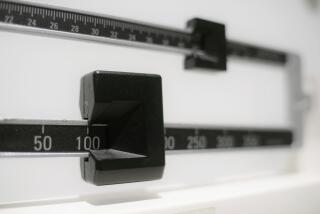The Seven-Day Rice Diet Now Is One for the Book
- Share via
Back in 1985, the 7-Day Rice Diet was an insert in the five-pound Uncle Ben’s rice canister. Today it’s available as a paperback, giving both the seven-day diet and 120 low-calorie rice recipes.
“The release of the diet in book form was tailored to coincide with public interest in dieting to lose pounds gained over the holiday season,” said Betty Wedman, a registered dietitian who was hired to help promote the diet.
The company’s search for a reduction diet that would appeal to the general public was directly related to increasing the use of rice as an alternative to pasta. “The public has heard a lot about pasta salads, but haven’t begun to use rice with the many meat, fish and vegetable combinations possible,” Wedman said.
The nice thing about Uncle Ben’s rice diet (not to be confused with the Duke University rice diet, which was designed for use within a medical facility under supervision) is that it is a normal balanced diet based on the four food groups, which can be used by the general public or anyone who wants to lose a few pounds soundly. The only hitch is that you use rice as a major starch in the diet, whether for breakfast, lunch or dinner.
Rice, unlike many carbohydrate foods, provides bulk on the plate for relatively few calories. “People on a diet need to fool themselves, so to speak, in feeling they are eating more than they really are so they don’t feel deprived,” Wedman said.
Rice is similar to wheat and other grains in calories, B vitamins, protein level and trace minerals. Compared with other grains, rice is the least allergenic. (Milk, eggs and wheat are highest on the food allergy scale, according to Wedman.) Rice also happens to be as versatile as pasta and can be served hot or cold, sweet or savory.
The average weight loss expected by following the diet is 1 1/2 to two pounds per week, with emphasis on changes in life style that include more exercise. “There is no magic in any diet. It’s a matter or learning how to eat,” Wedman said.
Wedman points out that one need not feel deprived while losing weight. “It’s the amount you eat that makes a difference, not what you eat,” she said.
The recipes in the book include an ethnic variety of dishes chosen specifically for their flavorful and colorful values.
“We were after variety, flavor and color that didn’t remind you of diet food,” Wedman said.
Some dishes appear as salads and recipes you can take along to work. “They are dishes that require preplanning so one is less likely to eat carelessly at lunch,” Wedman said.
The 7-Day Rice Diet calls for three meals based on the four food groups (an improvement on most popular diets) and limits foods high in fat, cholesterol and sodium. The 13 recipes that are part of the 7-Day Rice Diet conform strictly to the parameters of the diet. The remaining 120 recipes in the book cannot be substituted for the 7-Day Diet recipes. However, they may be used anytime after the initial seven-day diet period.
Here’s a day’s sampling of the diet and coordinated recipes. It would behoove the dieter to keep on hand already prepared rice for the lunchtime salad and other dishes called for in the diet. If there is anything that will render the diet ineffective it is the need to cook rice from scratch each time called for.
BREAKFAST
1/2 cup orange juice 1 bran muffin 1 teaspoon margarine LUNCH 1 serving Oriental Tuna Rice Salad 1 medium apple DINNER 1 serving Curried Orange Chicken 1/2 cup cooked peas and carrots 1 serving tossed vegetable salad 2 tablespoons low-calorie dressing Coffee, tea or diet soft drinks are optional beverages
Nutrition values: 1,047 calories, 65 grams protein, 25 grams fat, 142 grams carbohydrate, 1,949 milligrams sodium
ORIENTAL TUNA RICE SALAD
1 cup converted rice
2 1/2 cups water
3 tablespoons red wine vinegar
1 1/2 tablespoons oil
2 to 3 teaspoons soy sauce
1/2 to 3/4 teaspoon grated ginger root
1 (6 1/2-ounce) can tuna, packed in water, drained
1/2 cup bean sprouts
1/2 cup sliced celery
1/4 cup thinly sliced radishes
1 cup shredded spinach
Prepare rice with water according to package directions. Reserve 1 cup in medium bowl. Cool to room temperature. Cover and refrigerate remaining rice.
Combine vinegar, oil, soy sauce and ginger in small bowl. Add to reserved rice with tuna, bean sprouts, celery and radishes. Mix well. Cover and chill. Stir in spinach. Makes 2 servings.
Per Serving: 315 calories, 30 grams protein, 11 grams fat, 23 grams carbohydrate, 58 milligrams cholesterol, 794 milligrams sodium when prepared with 2 teaspoons soy sauce.
CURRIED ORANGE CHICKEN
3/4 to 1 1/4 teaspoons curry powder
1/2 teaspoon salt
Dash black pepper
2 chicken breast halves, boned and skinned
2/3 cup orange juice
2/3 cup water
1/2 cup converted rice
1 teaspoon brown sugar
1/2 teaspoon dry mustard
1 tablespoon chopped parsley
Combine curry powder, 1/4 teaspoon salt and pepper. Rub seasonings onto top and bottom surfaces of each chicken piece. Set aside.
Combine orange juice, water, rice, brown sugar, remaining salt and mustard in 8-inch skillet. Mix well. Bring to boil. Arrange chicken over rice. Cover and simmer 20 minutes. Remove from heat. Let stand, covered, until liquid is absorbed, about 5 minutes. Sprinkle with parsley. Makes 2 servings.
Per serving: 335 calories, 28 grams protein, 3 grams fat, 49 grams carbohydrate, 59 milligrams cholesterol, 587 milligrams sodium.
More to Read
Eat your way across L.A.
Get our weekly Tasting Notes newsletter for reviews, news and more.
You may occasionally receive promotional content from the Los Angeles Times.










